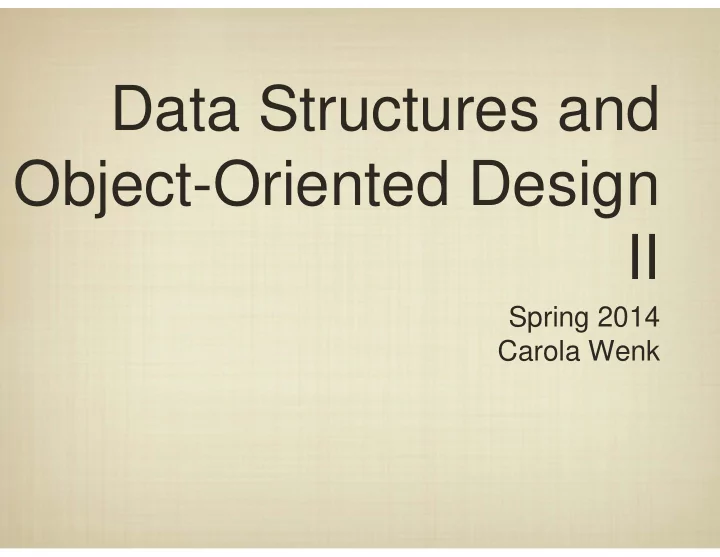

Data Structures and Object-Oriented Design II Spring 2014 Carola Wenk
Stacks • Are the methods in this class guaranteed to work? What kind of specifications can we guarantee to ensure the correctness of push and pop ? public int pop() { if (top >= 0) • How does pop handle empty stacks? return S[top--]; else public int pop() { return -999; return S[top--]; } } public int pop() { if (top >= 0) return S[top--]; } public int pop() { if (top >= 0) return S[top--]; else throw new RuntimeException(“Stack is empty”); }
Software Can Kill Meeting specifications is of critical importance when software is • used to control dangerous hardware. The Therac-25 relied on a software system to deliver different kinds of radiation: electron beam therapy, and X-ray therapy. These two types of radiation are used to treat different types of cancer.
Software Can Kill Meeting specifications is of critical importance when software is used to control dangerous hardware. Specification False False True False The Therac-25 radiation therapy system needed to guarantee that a shield is always in place when in “X-ray” mode. In certain instances the specification was not met, and as a result patients received 100x the allowable amount of radiation.
Software Can Kill Meeting specifications is of critical importance when software is used to control dangerous hardware. Specification False False True False An investigative commission found that the Therac-25 failed due to poor software development practices that led to a system that was difficult to verify or test.
Stack “Buffer Exploits” [wikipedia] Nearly every operating system utilizes a stack to manage the function calls. Programs can exploit the lack of a stack buffer check to modify the operating system and execute arbitrary code!
Java Runtime System import --; Java Compiler class HelloWorld { public void f(int x1, char x2, ...) { ... } public long g(boolean y1, float y2, ...) { ... } private int h(double z1, int z2, ...) { ... } Java “Byte” public static void main(String [] args) { System.out.println(“hello world!”) System.out.println(“goodbye world!”) Code } } Java Virtual Machine To CPU Operating System
Recent “zero-day” exploits (compromising Facebook, Twitter, Apple) utilize Java applets to circumvent OS security and install malware.
Java Virtual Machine Java “Byte” privileged access Code Operating System Recent “zero-day” exploits involving Java hide malicious code in Java applets that can circumvent built-in security provisions to install malware.
Limitations of Arrays One limitation of our implementation is that we have a set • capacity for our storage. “Push” “Pop” class Stack { ... public Stack(..) { ... } public int pop() { ... } public void push(int x) { ... }
Stacks How do we remove this limitation? In Python, we developed linked data structures that could “declare” new storage. What about in Java? class Node: def __init__(self, data = None, next = None): self.data = data self.next = None def __str__(self): return str(self.data) L = Node(‘a’) L.next = Node(123) L: ‘a’ 123
Stacks How do we remove this limitation? In Python, we developed linked data structures that could “declare” new storage. What about in Java? class Node{ private int data; private Node next; public Node(int d){ data = d; next = null; } public String toString() { return Integer.toString(data); } } L = new Node(1); L.next = new Node(123); L: 1 123
Array-Based Stack vs. DynamicStack public class DynamicStack implements Stack{ public class ArrayStack { final static int DEFAULT_CAPACITY=50; private class StackNode { private int[] S; private int data; private int top; private StackNode next; public ArrayStack(){ public StackNode(int d){ this( DEFAULT_CAPACITY); data = d; } next= null; } public ArrayStack(int capacity){ } S = new int[capacity]; top= ‐ 1; private StackNode top = null; } public void push(int x) { public void push(int x){ StackNode temp = new StackNode(x); S[++top]=x; temp.next = top; } top = temp; } public int pop(){ if(top>=0) public int pop(){ return S[top ‐‐ ]; if (top == null) else throw new RuntimeException("Stack empty!"); throw new RuntimeException("Stack is empty."); } int x = top.data; } top = top.next; return x; public class Tester{ } public static void main(String[] args) { } ArrayStack stack = new ArrayStack(); stack.push(5); If we change ArrayStack to System. out.println("popped: "+stack.pop()); } DynamicStack , the code still works. }
Java Interfaces We can specify that a Java class implements a particular kind • of functionality defined as an interface . public interface Stack { public int pop(); public void push(int x); } public class ArrayStack implements Stack { public class DynamicStack implements Stack { ... ... } } public class Tester { public static void main(String[] args) { Stack stack = new ArrayStack(); If we change ArrayStack to stack.push(5); System. out.println("popped: "+stack.pop()); DynamicStack , the code still works. } }
Recommend
More recommend